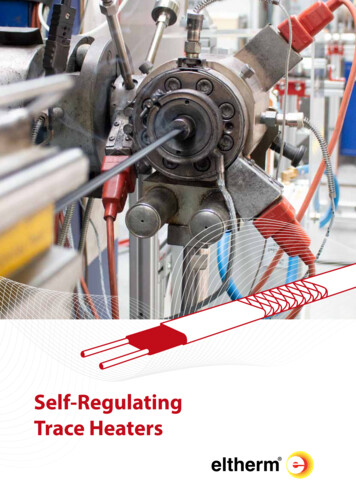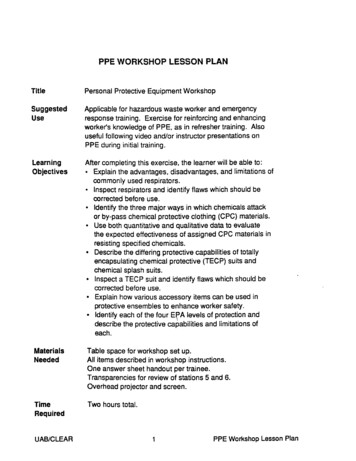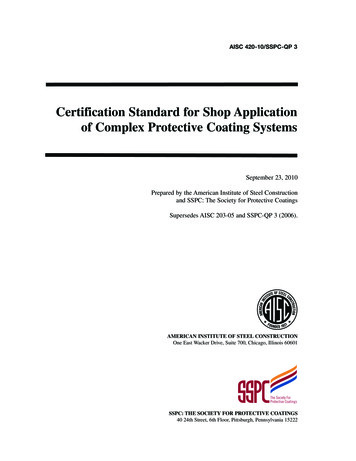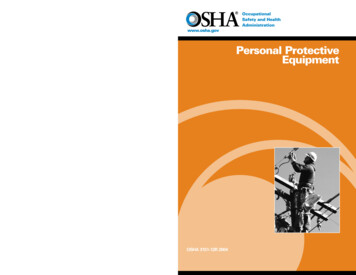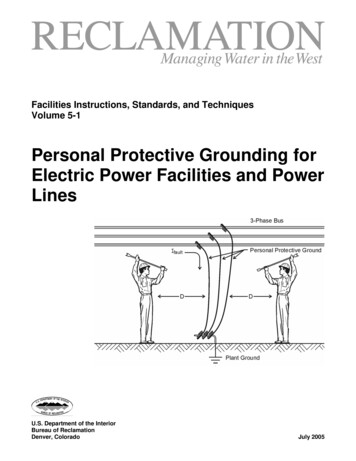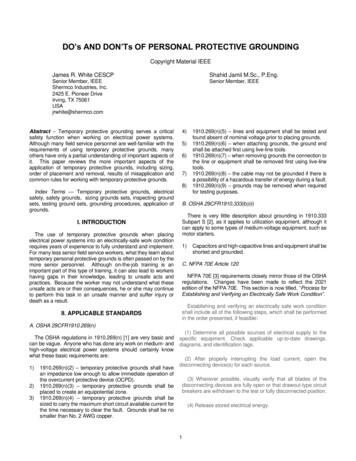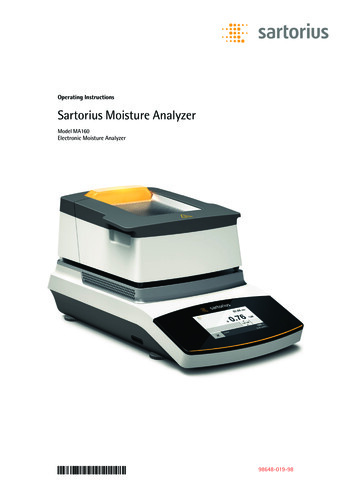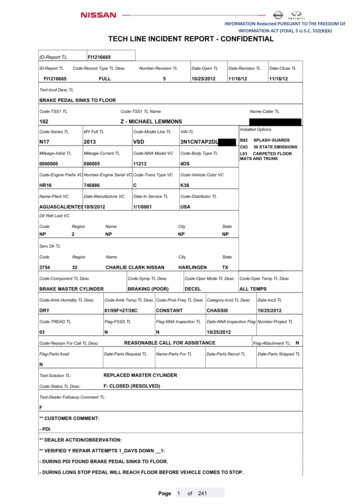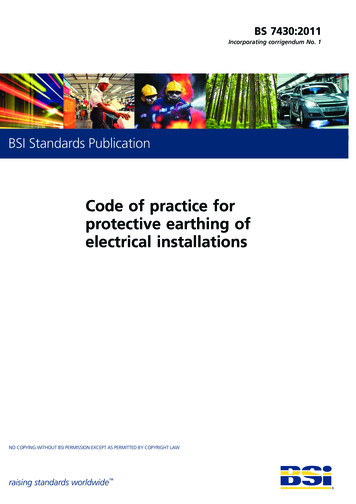
Transcription
BS 7430:2011Incorporating corrigendum No. 1BSI Standards PublicationCode of practice forprotective earthing ofelectrical installationsNO COPYING WITHOUT BSI PERMISSION EXCEPT AS PERMITTED BY COPYRIGHT LAWraising standards worldwide
BS 7430:2011BRITISH STANDARDPublishing and copyright informationThe BSI copyright notice displayed in this document indicates when the documentwas last issued. The British Standards Institution 2012Published by BSI Standards Limited 2012ISBN 978 0 580 78762 1ICS 13.260; 29.240.01The following BSI references relate to the work on this standard:Committee reference GEL/600Draft for comment 11/30249994 DCPublication historyFirst published as CP 1013:1965First published as BS 7430, January 1992Second edition, November 1998Third (present) edition, December 2011Amendments issued since publicationDateMay 2012Text affectedSee foreword
BRITISH STANDARDBS 7430:2011ContentsForeword12345678910iiiScope 1Normative references 1Terms and definitions 4Earthing principles 6HV/LV interface 12Low voltage installations 12Generators 19Special installations 29Earth electrode systems 33Inspection and testing of the earthing system66AnnexesAnnex A (informative) Guidance on typical HV/LV interfaces 79Annex B (informative) Typical simple installation of an earthing system for a small LV substation 85Bibliography88List of figuresFigure 1 – TN-S system 7Figure 2 – TN-C system 8Figure 3 – TN-C-S system 9Figure 4 – TT system 10Figure 5 – IT system 11Figure 6 – Earthing arrangement and protective conductors for consumers’installations 15Figure 7 – Small low voltage single phase generator run as a floating system 20Figure 8 – Small low voltage generator supplying a fixed installation 21Figure 9 – Small unearthed generator supplying a mobile or transportableunit 22Figure 10 – Low voltage standby generators with star-point switching 25Figure 11 – Low voltage standby generators with neutral earthingtransformers 26Figure 12 – Single low voltage standby generator (without parallelingfacility) 27Figure 13 – Measurement of earth resistivity 36Figure 14 – Impedence to earth of horizontal earth electrodes buried inhomogeneous soil 37Figure 14a – Effect of inter electrode spacing on combined resistance 39Figure 15 – Miscellaneous electrode configurations 41Figure 16 – Ground surface potentials around a single rod and three rods inline 47Figure 17 – Measurement of soil resistivity 68Figure 18 – One rod soil resistivity measurement 69Figure 19 – Measurement of earth electrode resistancef 71Figure 20 – Earth resistance curves 72Figure 21 – 3-terminal tester with CT clamp 74Figure 22 – Clamp-on tester 74Figure 23 – 90 /180 test 76Figure 24 – Typical 90 /180 test results 76Figure A.1 – TN-S system with separate HV equipment and LV neutral earths 79Figure A.2 – TN-S system with common HV equipment and LV neutral earth 80Figure A.3 – Segregated HV and LV earthing 82Figure A.4 – External HV switch supply 83Figure A.5 – Common external HV/LV interface to supply multiple buildings 84Figure A.6 – External HV/LV interface and generator backup 85 The British Standards Institution 2012 i
BS 7430:2011BRITISH STANDARDFigure B.1 – Assumed electrode arrangement for a small substation with a soilresistivity of 400 Ωm 86List of tablesTable 1 – Examples of soil resistivity in Ωm 35Table 2 – Factors for vertical electrodes arranged in a hollow square 43Table 3 – Geometric mean distance z for closely spaced reinforcing rods in asymmetrical pattern 45Table 4 – Factors for vertical parallel electrodes arranged in a line 48Table 5 – Earth fault current densities for 1 s duration for earthing conductorswith initial conductor temperature of 30 C 51Table 6 – Earth fault currents (in kA) for copper strip earthing conductors 52Table 7 – Earth fault currents (in kA) for aluminium strip earthingconductors 53Table 8 – Values of K and β 53Table 9 – Corrosion resistance of some electrodes materials related to soilparameters 60Table 10 – Suitability of materials for bonding together 61Table 11 – Material, configuration and minimum cross-sectional area of airtermination conductors, air termination rods, earth lead-in rods and downconductors 62Table 12 – Recommended materials for the manufacture of earthingcomponents 63Table 13 – 61.8% test probe spacing for various grid sizes 73Table 14 – Acceptable bonding readings within distribution substations 78Table 15 – Ground mounted plant installation model inspection form 78Summary of pagesThis document comprises a front cover, an inside front cover, pages i to iv,pages 1 to 88, an inside back cover and a back cover.ii The British Standards Institution 2012
BRITISH STANDARDBS 7430:2011ForewordPublishing informationThis British Standard is published by BSI Standards Limited, under licence fromThe British Standards Institution, and came into effect on 31 December 2011. Itwas prepared by Technical Committee GEL/600, Earthing. A list of organizationsrepresented on this committee can be obtained on request to its secretary.SupersessionThis British Standard supersedes BS 7430:1998, which is withdrawn.Information about this documentThe start and finish of text introduced or altered by Corrigendum No. 1 isindicated in the text by tags and .Relationship with other publicationsThis revision of BS 7430 takes into account changes in legislation(implementation of the Electricity Safety, Quality and Continuity Regulations2002 as amended [1]) and changes in and publication of other relevant industrystandards such as BS 7671:2008 A1, BS EN IEC 61936-1:2011 andBS EN 50522:2011.LegislationIn Great Britain earthing of an electricity supply system is governed by theElectricity Safety, Quality and Continuity Regulations 2002 as amended(ESQCR) [1] and the Electricity at Work Regulations 1989 [2]. In Northern Ireland,The Electricity Supply Regulations (Northern Ireland) 1988 as amended [3] apply.Presentational conventionsThe provisions in this standard are presented in roman (i.e. upright) type. Itsrecommendations are expressed in sentences in which the principal auxiliaryverb is “should”.Commentary, explanation and general informative material is presented insmaller italic type, and does not constitute a normative element.The word “should” is used to express recommendations of this standard. Theword “may” is used in the text to express permissibility, e.g. as an alternative tothe primary recommendation of the clause. The word “can” is used to expresspossibility, e.g. a consequence of an action or an event.Notes and commentaries are provided throughout the text of this standard.Notes give references and additional information that are important but do notform part of the recommendations. Commentaries give background information.Contractual and legal considerationsThis publication does not purport to include all the necessary provisions of acontract. Users are responsible for its correct application.Compliance with a British Standard cannot confer immunity from legalobligations. The British Standards Institution 2012 iii
BS 7430:2011iv The British Standards Institution 2012BRITISH STANDARDThis page deliberately left blank
BRITISH STANDARDBS 7430:20111 ScopeThis British Standard primarily provides recommendations and guidance onmeeting the requirements for the earthing of electrical installations, including:a)protective earthing of low voltage installations to BS 7671:2008 A1;b)the interface between LV and HV substations of 11 000/400 V toBS EN IEC 61936-1:2011 within buildings; andc)protective earthing and changeover switch arrangements for generatorssupplying low voltage installations.The earthing of a system or installation is generally provided for reasons ofsafety.This British Standard applies only to land-based installations in and aroundbuildings. It does not apply to:1)ships, aircraft or offshore installations;2)earthing of medical equipment [see BS EN 60601 (all parts)];3)special problems encountered with solid state electronic components;4)equipment sensitive to static electricity;5)requirements for functional earthing;6)earthing of overhead lines between electrical installations; or7)the internal earthing of equipment.2 Normative referencesThe following referenced documents are indispensable for the application ofthis document. For dated references, only the edition cited applies. For undatedreferences, the latest edition of the referenced document (including anyamendments) applies.BS 215-2:1970, Specification for aluminium conductors and aluminiumconductors, steel-reinforced for overhead power transmission – Aluminiumconductors, steel-reinforced (withdrawn) BS 729, Specification for hot dip galvanized coatings on iron and steelarticles (withdrawn) BS 951, Electrical earthing – Clamps for earthing and bonding – SpecificationBS 1400, Specification for copper alloy ingots and copper alloy and highconductivity copper castings (withdrawn)BS 1449:1991 (all parts), Steel plate, sheet and strip (withdrawn)BS 1473:1972, Specification for wrought aluminium and aluminium alloys forgeneral engineering purposes – Rivet, bolt and screw stockBS 1474:1987, Specification for wrought aluminium and aluminium alloys forgeneral engineering purposes: bars, extruded round tubes and sections(withdrawn)BS 1561:1997, Founding – Grey cast ironsBS 1562:1997, Founding – Malleable cast ironsBS 1377-3, Methods of test for soils for civil engineering purposes – Part 3:Chemical and electro-chemical testsBS 2754, Memorandum – Construction of electrical equipment for protectionagainst shock The British Standards Institution 2012 1
BS 7430:2011BRITISH STANDARDBS 2871-1:1971, Specification for copper and copper alloys – Tubes – Part 1:Copper tubes for water, gas and sanitation (withdrawn)BS 2871-2:1972, Specification for copper and copper alloys – Tubes – Part 2:Tubes for general purposes (withdrawn)BS 2871-3:1972, Specification for copper and copper alloys – Tubes – Part 3:Tubes for heat exchangers (withdrawn)BS 2873:1969, Specification for copper and copper alloys – Wire (withdrawn) BS 2874:1986, Specification for copper and copper alloy rods and sections(other than forging stock) (withdrawn) BS 3288-1, Insulator and conductor fittings for overhead power lines – Part 1:Performance and general requirementsBS 7375, Distribution of electricity on construction and demolition sites – Codeof practiceBS 7671:2008 A1:2011, Requirements For Electrical Installations – IEE WiringRegulations – Seventeenth editionBS EN 485-2:2008, Aluminium and aluminium alloys – Sheet, strip and plate –Part 2: Mechanical propertiesBS EN 586-2:1994, Aluminium and aluminium alloys – Forgings – Part 2:Mechanical properties and additional property requirementsBS EN 755-2:2008, Aluminium and aluminium alloys – Extruded rod/bar, tube andprofiles – Part 2: Mechanical propertiesBS EN 1011-4, Welding – Recommendations for welding of metallic materials –Part 4: Arc welding of aluminium and aluminium alloysBS EN 1652:1998, Copper and copper alloys – Plate, sheet, strip and circles forgeneral purposesBS EN 1780-1:2002, Aluminium and aluminium alloys – Designation of alloyedaluminium ingots for remelting, master alloys and castings – Part 1: Numericaldesignation systemBS EN 1982:2008, Copper and copper alloys – Ingots and castingsBS EN 10025-2:2004, Hot rolled products of structural steels – Part 2: Technicaldelivery conditions for non-alloy structural steelsBS EN 10088-1:2005, Stainless steels – List of stainless steelsBS EN 10263-4:2001, Steel rod, bars and wire for cold heading and coldextrusion – Technical delivery conditions for steels for quenching and temperingBS EN 12163:2011: Copper and copper alloys – Rod for general purposesBS EN 12165:2011, Copper and copper alloys – Wrought and unwrought forgingstockBS EN 12167:2011, Copper and copper alloys – Profiles and bars for generalpurposesBS EN 12420:1999, Copper and copper alloys – ForgingsBS EN 12449:1999, Copper and copper alloys – Seamless, round tubes for generalpurposesBS EN 12601, Reciprocating internal combustion engine driven generating sets –Safety BS EN 13601:2002, Copper and copper alloys – Copper rod, bar and wire forgeneral electrical purposes 2 The British Standards Institution 2012
BRITISH STANDARDBS 7430:2011BS EN 50122-1, Railway applications – Fixed installations – Electrical safety,earthing and the return circuit – Part 1: Protective provisions against electricshockBS EN 50122-2, Railway applications – Fixed installations – Electrical safety,earthing and the return circuit – Part 2: Provisions against the effects of straycurrents caused by d.c. traction systemsBS EN 50164-2, Lightning protection components (LPC) – Part 2: Requirementsfor conductors and earth electrodesBS EN 50522:2011, Earthing of power installations exceeding 1 kV a.c.BS EN 60228:2005, Conductors of insulated cablesBS EN 60309/IEC 60309 (all parts), Plugs, socket-outlets and couplers forindustrial purposes BS EN 61010 (all parts), Safety requirements for electrical equipment formeasurement, control, and laboratory use BS EN 60909-0/IEC 60909-0, Short-circuit currents in three-phase a.c. systems –Part 0: Calculation of currentsBS EN 61008-1, Specification for residual current operated circuit-breakerswithout integral overcurrent protection for household and similar uses (RCCBs) –Part 1: General rulesBS EN 61557/IEC 61557 (all parts), Electrical safety in low voltage distributionsystems up to 1 000 V a.c. and 1 500 V d.c. – Equipment for testing, measuringor monitoring of protective measuresBS EN 61558-2-4/IEC 61558-2-4, Safety power transformers, reactors, powersupply units and similar products for supply – Part 2-4: Particular requirementsand tests for isolating transformers and power supply units incorporatingisolating transformersBS EN 62305-1, Protection against lightning – Part 1: General requirementsBS EN 62305-2, Protection against lightning – Part 2: Risk managementBS EN 62305-3, Protection against lightning – Part 3: Physical damage tostructures and life hazardBS EN 62035-4, Protection against lightning – Part 4: Electrical and electronicsystems within structuresBS IEC 60050-195, International electrotechnical vocabulary – Part 195: Earthingand protection against electric shockBS IEC 61000-5-2, Electromagnetic compatibility (EMC) – Part 5: Installation andmitigation guidelines – Section 2: Earthing and cablingBS EN IEC 61936-1:2011, Power installations exceeding 1 kV a.c. – Part 1:Common rulesDD IEC/TS 60479-1:2005, Effects of current on human beings and livestock –Part 1: General aspectsER G59, Recommendations for the connection of embedded generating plant tothe Regional Electricity Companies’ distribution systemsER G83, Recommendations For The Connection Of Small-Scale EmbeddedGenerators (Up To 16 A Per Phase) In Parallel With Public Low-VoltageDistribution NetworksER G84, Recommendations for the Connection of Mobile Generating Sets toPublic Distribution Networks The British Standards Institution 2012 3
BS 7430:2011BRITISH STANDARDER S36-1, Identification and Recording of “Hot Sites” – Joint ElectricityIndustry/BT ProcedureISO/IEC Guide 51, Safety aspects – Guidelines for their inclusion in standards IEC 60050-604, International electrotechnical vocabulary – Part 604:Generation, transmission and distribution of electricity – Operation IEC Guide 104, The preparation of safety publications and the use of basic safetypublications and group safety publicationsPD 970:2005, Wrought steels for mechanical and allied engineering purposes –Requirements for carbon, carbon manganese and alloy hot worked or coldfinished steels3 Terms and definitionsFor the purposes of this British Standard, the terms and definitions given inBS 7671:2008 A1 and BS IEC 60050-195, together with the following apply.3.1earth gridearth electrode in the form of two overlapping groups of buried, parallel,horizontal electrodes, usually laid approximately at right angles to each other,with the electrodes bonded at each intersection3.2earth potentialelectric potential with respect to the general mass of earth which occurs in, oron the surface of, the ground around an earth electrode when an electriccurrent flows from the electrode to earth3.3earth potential risevoltage between an earthing system and reference earth[BS EN 50522:2011]3.4earth resistanceresistance to earth of an earth electrode or earth grid3.5earthing systemarrangement of connections and devices necessary to earth equipment or asystem separately or jointly[ IEC 60050-604, 604-04-02]3.6global earthing systemequivalent earthing system created by the interconnection of local earthingsystems that ensures, by the proximity of the earthing systems, that there are nodangerous touch voltagesNOTE 1 Such systems permit the division of the earth fault current in a way thatresults in a reduction of the earth potential rise at the local earthing system. Such asystem could be said to form a quasi equipotential surface.NOTE 2 The existence of a global earthing system may be determined by samplemeasurements or calculation for typical systems. Typical examples of global earthingsystems are in city centres; urban or industrial areas with distributed low- andhigh-voltage earthing.[BS EN 50522:2011]4 The British Standards Institution 2012
BRITISH STANDARD3.7BS 7430:2011hot sitesubstation where the rise of earth potential, under the maximum earth faultcondition, can exceed the value either 430 V or 650 V depending upon the faultclearance time3.8potential gradient (at a point)rate of change of voltage measured at that point in the direction in which it is amaximum3.9transferred potentialpotential rise of an earthing system caused by a current to earth transferred bymeans of a connected conductor (for example a metallic cable sheath, PENconductor, pipeline, rail) into areas with low or no potential rise relative toreference earth resulting in a potential difference occurring between theconductor and its surroundingsNOTE 1 The definition also applies where a conductor, which is connected toreference earth, leads into the area of the potential rise.NOTE 2 Transferred potentials can result in electrocution paths through the humanbody other than the “touch voltage” path, e.g. hand to hand[BS EN 50522:2011]3.10(effective) touch potentialvoltage between conductive parts when touched simultaneouslyNOTE The value of the effective touch voltage may be appreciably influenced bythe impedance of the person in electric contact with these conductive parts.[IEV 195-05-11, modified]3.11prospective touch potentialvoltage between simultaneously accessible conductive parts when thoseconductive parts are not being touched[IEV 195-05-09, modified]3.12step voltagestep potentialvoltage between two points on the earth’s surface that are 1 m distant fromeach other, which is considered to be the stride length of a person[ BS IEC 60050-195, 195-05-12]3.13 transferred potentialpotential rise of an earthing system caused by a current to earth transferred bymeans of a connected conductor (for example a metallic cable sheath, PENconductor, pipeline, rail) into areas with low or no potential rise relative toreference earth resulting in a potential difference occurring between theconductor and its surroundingsNOTE 1 The definition also applies where a conductor, which is connected toreference earth, leads into the area of the potential rise.NOTE 2 Transferred potentials can result in electrocution paths through the humanbody other than the “touch voltage” path, e.g. hand to hand.[BS EN 50522:2011]3.14(effective) touch potentialvoltage between conductive parts when touched simultaneouslyNOTE The value of the effective touch voltage may be appreciably influenced bythe impedance of the personin electric contact with these conductive parts. The British Standards Institution 2012 5
BS 7430:2011BRITISH STANDARD[BS IEC 60050-195, 195-05-11, modified] 4 Earthing principles4.1Fundamental rule of protection against electric shockBS EN 61140 gives fundamental principles and requirements which are commonto electrical installations, systems and equipment or necessary for theirco-ordination, for installations, systems and equipment without a voltage limit.BS EN 61140 states that the fundamental rule of protection against electricshock is that: hazardous-live-parts shall not be accessible and accessible conductive partsshall not be hazardous live: either under normal conditions (operation in intended use, see ISO/IECGuide 51, 3.13 and absence of a fault); or under single-fault conditions (see also IEC Guide 104, 2.8).The system and equipment standards are being amended to comply withBS EN 61140 so that the fundamental rule is met and to adopt the sameterminology.In order to achieve the principles within BS EN 61140 within electricalinstallations standards, BS 7671:2008 A1 makes certain requirements for theearthing of an installation and its sub-structure in order to achieve safety. Withthe exception of earth free locations, the main requirement under single faultconditions is for automatic disconnection of supply with selecting cableimpedances in order to achieve certain touch voltages.4.24.2.1Supply system earthingLegislationIn Great Britain the earthing of an electricity supply system is covered by therequirements of the Electricity Safety Quality and Continuity Regulations 2002 asamended (ESQCR) [1]. Part II, Protection and Earthing is particularly relevant tousers of this standard. Guidance is given in DTI publication Guidance on theElectricity Safety, Quality and Continuity Regulations [4].In Northern Ireland, regulations made by the Ministry of Commerce for NorthernIreland apply. The general provisions in the ESQCR [1] apply to both overheadand underground systems of supply.The regulations require that every network at whatever voltage be connectedwith Earth and that the connection is maintained under fault conditions[Regulation 8(1)]. This requirement is designed primarily to preserve the securityof the system by ensuring that the potential on each conductor is restricted tosuch a value as is consistent with the level of insulation applied. Every supplyneutral conductor (of LV networks) is required to be connected with earthgenerally at the source of voltage [Regulation 8 (3(b))].The regulations include a particular requirement where the neutral andprotective conductors are combined that is in protective multiply earthed (PME)systems (see Regulation 9). This is the most common system adopted, seeFigure 3. 4.2.2High voltage (HV) power supply systemsNOTE Requirements for earthing HV installations are given inBS EN IEC 61936-1:2011 and BS EN 50522:2011. See also Clause 5.6 The British Standards Institution 2012
BRITISH STANDARD4.2.34.2.3.1BS 7430:2011Classification of low voltage systemsGeneralFor the purpose of this standard the following earthing systems are defined:TN-S, TN-C, TN-C-S, TT and IT.4.2.3.2TN-S systemIn a TN-S (Figure 1) the Neutral and Protective conductors should be keptseparate throughout the system and the source is solidly earthed.Figure 1Key123TN-S systemSource of energyConsumers’ installationsAdditional source earth45PESource earthEquipment in installationProtective earthCOMMENTARY ON 4.2.3.2A TN-S system has a particular disadvantage that in the event that the protectiveconductor becomes open circuit, there is no indication that a fault has occurred andinstallations can unknowingly be left without an earth. In the event of an earthfault all of the exposed-conductive-parts within a consumer installation may beraised to a hazardous potential. Earth fault protection devices will not operate asthere will be no flow of current to earth.4.2.3.3TN-C systemIn a TN-C system (Figure 2) the neutral and protective functions should becombined in a single conductor (PEN) throughout the entire system. Multipleconnections to earth are recommended along the PEN conductor and the sourceis solidly earthed. The British Standards Institution 2012 7
BS 7430:2011Figure 2Key123PENBRITISH STANDARDTN-C systemSource of energy4Consumers’ installations5Additional source earth6Combined protective and neutral conductorSource earthEquipment in installationExposed-conductive-partsCOMMENTARY ON 4.2.3.3The need for multiple earth connections is because if the neutral becomesopen-circuit for any reason, the exposed-conductive-parts will rise to line to earthvoltage in the case of single-phase connections and a value up to line to earthvoltage in the case of three-phase connections, depending on the degree to whichthe load is unbalanced.4.2.3.4TN-C-S systemIn a TN-C-S system, (Figure 3) the neutral and protective functions should becombined in a single conductor (PEN) from the source (solidly earthed) up to theconsumers intake. Multiple connections to earth are recommended along thePEN conductor. Within the consumer’s installation the neutral and protectiveconductors should be kept separate.8 The British Standards Institution 2012
BRITISH STANDARDFigure 3Key123PENBS 7430:2011TN-C-S systemSource of energy4Consumers’ installations5Additional source earth6Combined protective and neutral conductorSource earthEquipment in installationExposed-conductive-partsCOMMENTARY ON 4.2.3.4The TN-C-S system is also known as a “protective multiple earthed” (PME) system.The PEN conductor, which is referred to as a combined neutral and earth (CNE)conductor, is earthed at the source and extremities of the distribution mains andpoints in-between; hence the reference to multiple earthing. Multiple earthing ofthe CNE conductor ensures that if the conductor becomes open-circuit for anyreason, exposed-conductive-parts remain connected to earth; under such conditionsthe supply voltage between the installation line and neutral conductors issubstantially reduced and consumers will experience unacceptable voltage variations.4.2.3.5TT installationA TT system (Figure 4) has a solidly earthed source; the exposed-conductive-partsof the consumer’s installation are earthed through an installation earthelectrode which is electrically independent of the source earth. The British Standards Institution 2012 9
BS 7430:2011Figure 4Key123BRITISH STANDARDTT systemSource of energyConsumers’ installationsSource earth456Equipment in installationExposed-conductive-partsInstallation earth electrodeCOMMENTARY ON 4.2.3.6In the TT system the earth fault loop impedance is generally high as the fault pathincludes the earth electrode resistance of the supply and the earth electroderesistance of the consumer’s installation.4.2.3.6IT systemAn IT system (Figure 5) has the source either connected to earth through anearthing impedance or is isolated (Insulated) from the earth. All of theexposed-conductive parts of an installation are connected to an earth electrodein a similar manner to a TT arrangement.10 The British Standards Institution 2012
BRITISH STANDARDFigure 5Key1234BS 7430:2011IT systemSource of energyEarthing impedenceConsumers’ installationsSource earth567Equipment in installationExposed-conductive-partsInstallation earth electrodeCOMMENTARY ON 4.2.3.7Generally an IT system would be chosen in locations such as medical centres andmines where the supply has to be maintained even in the event of a fault, andwhere the connection with earth is difficult (for example a mobile generator).4.3Installation earthing – Low-voltage (LV) installation earthingThe purpose of earthing the non-current carrying metalwork of plant andequipment of a low-voltage installation is to:a)provide for a low earth fault loop impedance to facilitate automaticdisconnection of supply in the event of a fault to exposed-conductive-parts;andb)limit the rise of potential under earth-fault conditions of non-currentcarrying metalwork with respect to earth to increase the safety of personsand animals in proximity to such metalwork.Extending the earthing arrangement of an installation within a building by useof protective equipotential bonding of exposed-conductive-parts andextraneous-conductive-parts increases the safety of persons and animals byreducing touch voltages between such parts and it can also eliminate dangeroussparking.The performance requirements for earthing of LV installations(e.g. disconnection times, conductor sizes) are specified in BS 7671:2008 A1. Attention is drawn to the fact that BS 7671:2008 A1, Regulation 411.3.2.6has a relaxation: The British Standards Institution 2012 11
BS 7430:2011BRITISH STANDARD411.3.2.6 Where automatic disconnection according to Regulation 411.3.2.1cannot be achieved in the time required by Regulation 411.3.2.2, 411.3.2.3 or411.3.2.4, as appropriate, supplementary equipotential bonding shall beprovided in accordance with Regulation 415.2. Also, Regulation 411.4.9permits RCD protection to be used to satisfy the requirements of theseregulations and maximum values of earth fault loop impedance are nowprovided in Table 41.5 within this standard.4.4Current-using equipmentThe purpose of earthing current-using equipment is similar to that for earthingelectrical installations. However, for certain standards, e.g. those in theBS EN 60335 series, automatic disconnection of supply is not required in theevent of a fault to accessible conductive parts (see BS EN 60335-1:2002 A14,Clause 27).27 Provision for earthing27.1 Accessible metal parts of class 0I appliances and class I appliances thatmay become live in the event of an insulation fault, shall be permanently andreliably connected to an earthing terminal within the appliance or to theearthing contact of the appliance inlet. Earthing terminals and earthingcontacts shall not be connected to the neutral terminal.The fuse in the BS 1363 plug fitted to appliances in the UK is not required bythe relevant part of BS EN 60335; its rating is selected to provide protection tothe flexible cable supplying the appliance.In the remainder of Europe, plug fuses are not required.5 HV/LV interfaceSpecific require
Third (present) edition, December 2011 Amendments issued since publication Date Text affected May 2012 See foreword BS 7430:2011 BRITISH STANDARD Licensed copy: IP User, Kingston University Libr



